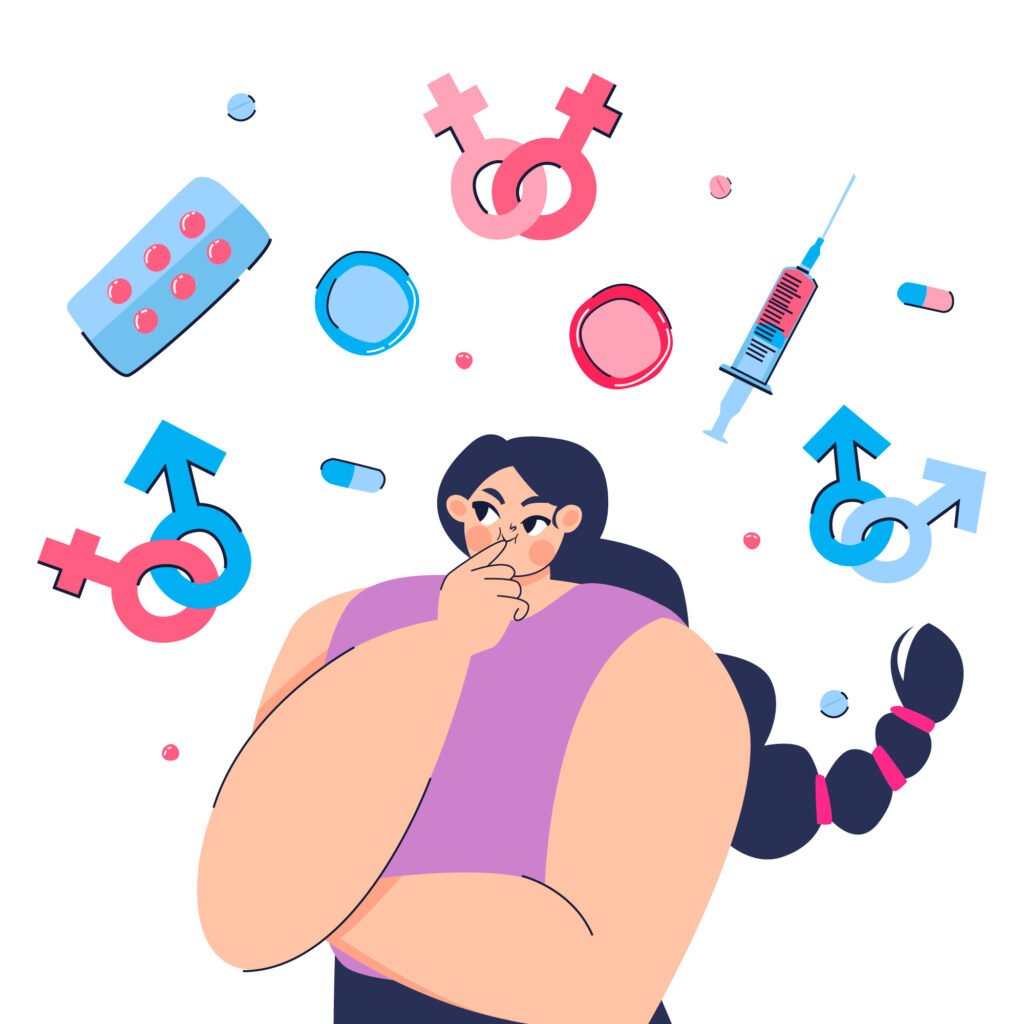
Sexuality and Health
Topic Overview
As part of this topic, the elderly will gain knowledge about the importance of sexuality for their health, the benefits of an active sex life, and what preventive measures are at different levels of treatment. They will also learn about the most common sexually transmitted diseases and how to protect themselves from them.
Aims and objectives
Learning outcomes
Having successfully completed this topic you will be able to:
- Understand the meaning of sexuality for elderly’s health status.
- Understanding basic facts about preventive measures at primary, secondary and tertiary level of treatment.
- Understand the importance of health education regarding the sexually transmitted diseases and how to act so as not to get infected.
- Understand safe sex practices.
Benefits of Intimacy for Older Adults
Sexual interest may decrease with age, however, try not to reduce the activity of being intimate with your partner because intimacy and sex contribute to a happy and healthy relationship, whether on an emotional level (e.g. sharing shared experiences) or on a physical level (e.g. intercourse, cuddling).
Sexual activity also contributes to:
- experiencing less stress, as the partner’s emotional and other support strengthens the ability to manage stress.
- better healing, as the psychological support and encouragement of the partner influences better treatment during illness, treatment or surgery.
- reducing the risk of depression, as social support contributes to fewer emotional problems such as anxiety and depression (Mayo clinic, 2022).
We all are sexual beings, so sexual health is essential to our well-being throughout life. It is crucial to be aware of the physical, emotional and social factors that affect our sexual health (National Council on Aging, 2023).
All elderly people, regardless of gender or sexual orientation, should be able to enjoy a satisfying and fulfilling sex life. As we age, interest in sex declines to some extent, so it is necessary to know how our sexual responses and feelings change and learn to enjoy our sex life despite these changes (AGS Health in Aging Foundation, 2023).
Video Resources
(Gerocast, 2021)
(AlturaLearning, 2016)
Module 2.2
Health prevention

Prevention of disease in older adults
Disease prevention is aimed at preventing the occurrence of a disease or the worsening of a disease. Disease prevention measures benefit independent, older people with minimal or no chronic disease, as well as older people with multiple incurable but treatable conditions (Lenartowicz, 2022).
Primary and Secondary Prevention: The goal of primary prevention is to stop the disease before it occurs, namely by reducing or eliminating risk factors. Most often, primary prevention includes immunoprophylaxis (vaccination), chemoprophylaxis and lifestyle changes (Lenartowicz, 2022).
The goal of secondary prevention is to detect the disease and potential complications of the disease at an early stage and treat it appropriately before symptoms or functional losses occur. Early detection of the disease also reduces morbidity and mortality (Lenartowicz, 2022)
Screening
Screening testing can thus be a primary or secondary preventive measure. Screening can identify risk factors that can be modified to prevent disease, or to detect disease in asymptomatic people who can then be treated at an early stage of the disease.
There are several guidelines for screening, but they sometimes differ. Regardless of the recommendations of the guidelines, it is necessary to take into account the individual characteristics and wishes of the patient (Lenartowicz, 2022).
Tertiary prevention
Tertiary prevention is aimed at the existing symptomatic, where there is in most cases a chronic disease that is properly managed, with the aim of preventing further functional loss. Disease-specific clinical practice guidelines and protocols are used to manage the disease. Several disease control programs have also been developed:
Management of disease-specific medical care: specially trained medical personnel such as a nurse who works with a primary care physician or a geriatrician who coordinates the patient’s protocol-based medical care, also organizes support services for the patient and examines the patient individually Chronic Care
Outpatient Clinics: where patients with the same chronic disease are examined in groups and they are attended by a health professional; such an approach may help patients with diabetes achieve better glucose control.
Specialist doctors: Patients with a chronic disease who are difficult to stabilize are referred to a specialist doctor. This approach works best when the specialist and the primary care physician work together (Lenartowicz, 2022).
Elderly patients with chronic diseases listed below can especially benefit from tertiary prevention:
Osteoporosis – Osteoporosis is detected by bone density tests, preferably before a fracture occurs. We reduce the risk and prevent the progression of osteoporosis by adding calcium and vitamin D to our diet, regular exercise and quitting smoking. Also appropriate treatment prevents new fractures (Lenartowicz, 2022)
Diabetes – In diabetes, the body does not produce enough insulin or cannot use it as well as it should. When there is not enough insulin or the cells stop responding to insulin, too much blood sugar remains in the bloodstream. Over time, this can lead to serious health problems such as heart disease, vision loss, and kidney disease (Centers for Disease Control and Prevention, 2023). When the concentration of glycosylated hemoglobin (HbA1C) is > 7.9% for at least 7 years, it increases the risk of retinopathy, neuropathy, nephropathy and coronary artery disease. In patients with diabetes, the control of hypertension and dyslipidemia is particularly important. Also, patient education and foot examinations at each doctor’s visit can help prevent foot ulcers (Lenartowicz, 2022).
Arthritis – causes impaired mobility and increases the risk of osteoporosis, aerobic and muscle deconditioning, falls and pressure ulcers. Arthritis affects about half of people aged ≥ 65 years (Lenartowicz, 2022).
Vascular disorders – Elderly patients diagnosed with coronary artery disease, cerebrovascular disease, or peripheral vascular disease are at high risk of disability. The risk can be reduced by aggressive management of vascular risk factors (eg, hypertension, smoking, diabetes, obesity, atrial fibrillation, dyslipidemia) (Lenartowicz, 2022).
Heart failure – Morbidity from heart failure, as well as mortality from heart failure, is high among older adults. Adequate and even aggressive treatment, especially of systolic dysfunction, reduces functional decline, hospitalization and mortality (Lenartowicz, 2022).
Chronic obstructive pulmonary disease (COPD) – The risks of worsening the disease can be reduced by quitting smoking, using medicines and inhalers appropriately. Educating patients on energy conservation techniques can also reduce the number and severity of COPD exacerbations, which in the worst-case scenario may lead to hospitalization (Lenartowicz, 2022).
Video Resources
(Science Animated, 2018)
(The Everett Clinic, 2008)
(Charleston Area Medical Center, 2019)
Glossary & Acronyms
Disability – Disability is a physical, mental, intellectual or sensory impairment, which, in interaction with various barriers, may hinder people in their full and effective participation in society on an equal basis with others (AGE Platform Europe, 2023).
Module 2.3
Sexually transmitted diseases

Sexually Transmitted Diseases in Older Adults
Sexually active older people may be at risk for diseases such as syphilis, gonorrhea, chlamydial infection, genital herpes, hepatitis B, genital warts, and trichomoniasis. In fact, STDs are on the rise among the elderly. Almost anyone who is sexually active and has a non-permanent partner is also at risk of contracting HIV, the virus that causes AIDS. Due to the exposure and the fact that even in old age we are not protected from sexually transmitted diseases, education about this is essential (Benjamin Rose Institute on Aging, 2019).
Health professionals often view sexually transmitted diseases (STDs) as infections that are contracted mainly by younger people through sexual contact with infected people. The reason lies in the assumption that the elderly are less sexually active than younger people, yet the number of sexually transmitted diseases is increasing among people aged 50 and over (Purpora, 2012). The sexually transmitted diseases chlamydia, gonorrhea and HIV occur most often among the elderly and include both newly acquired infections and residual complications.
Most Common STDs in Older Adults
Chlamydia – is caused by the bacterium Chlamydia trachomatis. Both men and women can be asymptomatic, symptoms in women include abnormal vaginal discharge, dysuria, abnormal vaginal bleeding and pelvic pain (Uphold & Graham, 2003). Men describe symptoms such as purulent urethral discharge and burning urination. Chlamydia is a common cause of cervicitis in women and urethritis in men, but both sexes can experience chlamydial conjunctivitis, which can cause a red and sticky discharge from one or both eyes and swollen eyelids. In some cases, the cornea may be affected. Therefore, an eye examination is a key part of the examination and can help in establishing a diagnosis, but laboratory tests are necessary for a definitive diagnosis (Mayo Foundation for Medical Education and Research (MFMER), 2023). This may include an antigen test, a urine test, or a swab culture test. The consequences of untreated chlamydia include infertility in people of childbearing age, but the infection can also cause complications such as Reiter’s syndrome (a type of arthritis caused by the body’s reaction to a bacterial infection), which can affect people of any age. The results of the research also confirmed the link between chlamydia and the risk of cervical cancer, and it is believed that chlamydia can prolong human papillomavirus (HPV) (American Cancer Society, 2020), which is the least common sexually transmitted disease in older patients. One study showed only a 6% prevalence of HPV among women aged 57 to 85 (Lindau, Drum, Gaumer, Surawska, & Jordan, 2008). While chlamydia, in contrast to HPV, accounts for the largest proportion of all sexually transmitted diseases (World Health Organization, 2022).
Gonorrhea – the bacterium Neisseria gonorrhoeae is the causative agent of the sexually transmitted disease gonorrhea and can develop in the cervix, uterus, fallopian tubes, urethra, mouth, throat, eyes and anus. Symptoms include urethritis in men and slight discharge and dysuria in women. However, many infections in women do not cause symptoms until complications such as pelvic inflammatory disease develop (Uphold & Graham, 2003). Like chlamydia, gonorrhea causes eye problems in both sexes, including eye pain, sensitivity to light, and purulent discharge from the affected eye. Laboratory tests are required for a definitive diagnosis (Mayo Foundation for Medical Education and Research (MFMER), 2023).
HIV – symptoms of HIV infection can appear within 2 to 4 weeks of exposure and include a variety of symptoms such as fever, chills, rashes, night sweats, muscle pain, sore throat, fatigue, swollen lymph nodes, and mouth ulcers (HIV.gov, 2022). HIV is an infection that kills cells of the immune system, especially CD4+ T-cells (T-lymphocytes) (Uphold & Graham, 2003). In the vast majority of individuals, people begin to feel ill already after the progression of HIV infection to AIDS (HIV.gov, 2022). About 11% of new HIV infections occur in adults aged 50 years and older (Brooks, Buchacz, Gebo, & Mermin, 2012), and patients may have the same risk factors for HIV infection and other STDs as younger adults. The number of older adults living with HIV/AIDS has increased, thanks to better antiretroviral treatment, which in turn means that people living with HIV are living longer. There are also more newly diagnosed infections in people over the age of 50 (Uphold & Graham, 2003). Individuals with sexually transmitted diseases are known to be at least two to five times more likely to become infected with HIV if they are exposed to HIV, because sexually transmitted diseases cause inflammation, which increases the concentration of cells in the genital secretions, which can serve as a focus for HIV infection (Centers for Disease Control and Preventive, 2022).
Patient Education
The elderly often think that they are not at risk for sexually transmitted diseases. On average, a person over 50 years old does it two to four times a month (Xu, Schillinger, Aubin, St. Louis, & Markowitz, 2001). It is important for the elderly to understand that sexual activity includes everything that exposes them to bodily secretions. This includes vaginal or anal sex, giving or receiving oral sex, and masturbation (Purpora, 2012).
The immune system weakens with aging, which makes the elderly more exposed to a greater risk of sexually transmitted diseases and other infectious diseases. In older women, the thinning of the vaginal walls after menopause can cause tearing during sexual activity, which facilitates the transmission of the disease (Letvak & Schoder, 1996; (Xu, Schillinger, Aubin, St. Louis, & Markowitz, 2001; Patel, Gillespie, & Foxman, 2003). In men, the aging process can cause sexual dysfunction. This is even more pronounced in patients with chronic diseases or those taking drugs with sexual side effects. In men over 60 years of age, the ability to ejaculate decreases (Dunn & Cutler, 2000).
Safe sex practices
- Use a latex condoms
- Limit the number of sexual partners
- Practice other forms of intimacy
- Regular STD screening
- Prevention education
- Communicate with partner
- Don’t have anonymous casual sex (Harken, Howe, & Ludwick, 2014)
Video Resources
(Medical Centric, 2021)
Glossary & Acronyms
STD – Sexually transmitted diseases

Funded by the European Union. Views and opinions expressed are however those of the author(s) only and do not necessarily reflect those of the European Union or the European Education and Culture Executive Agency (EACEA). Neither the European Union nor EACEA can be held responsible for them.
